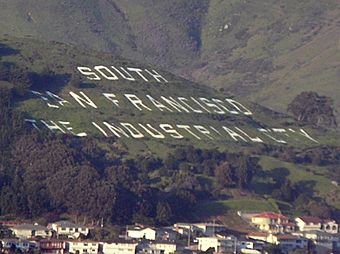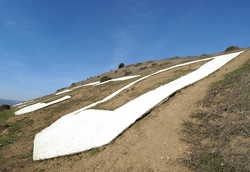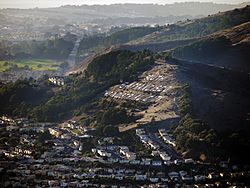South San Francisco hillside sign facts for kids
Quick facts for kids |
|
|
South San Francisco Hillside Sign
|
|
 |
|
| Location | Sign Hill Park, North of Park Way, South San Francisco, California |
|---|---|
| Area | 41 acres (17 ha) |
| Architect | Klassen, Robert A.; Kneese, George A. |
| NRHP reference No. | 96000761 |
| Added to NRHP | July 11, 1996 |
The South San Francisco Hillside Sign is a famous sign on a hill that looks over the city of South San Francisco, California. It's in San Mateo County, California. This special sign was first made in the 1920s. It was added to the National Register of Historic Places in 1996.
The sign is the main part of Sign Hill Park. This city park has about 30 acres (12 ha) of open space. It also has almost 2 miles (3.2 km) of trails for hiking. You can even walk right up to the letters of the sign!
The sign spells out "SOUTH SAN FRANCISCO THE INDUSTRIAL CITY". The letters are made of concrete and painted white. People driving north on U.S. 101 can see it. It's also easy to spot from planes flying into San Francisco International Airport.
What Does the Sign Look Like?
The letters are on the south side of a steep hill. This hill is about 581 feet (177 m) tall and is part of the San Bruno Mountains. The hill is not flat, but the letters look straight and the same size from far away. This is because they used a special trick called anamorphosis. It means the letters are actually different heights, from 48 to 65 feet (15 to 20 m) tall.
The first line, "SOUTH", is 166 feet (51 m) long. The second line, "SAN FRANCISCO", is 484 feet (148 m) long. The third line, "THE INDUSTRIAL CITY", is 628 feet (191 m) long. The letters are mostly in good shape. Only the "T" in "CITY" has a small gap. Its top part is about 40 inches (1,000 mm) away from its bottom part.
The Story Behind the Sign
The first version of the sign was put on the hillside in 1923. A city engineer named George A. Kneese carefully planned each letter. This made sure they looked evenly spaced and clear. The first letters were carved into the hill. Then, they were filled with a white paint mix made of lime, white cement, and water. This first sign was finished by November 22, 1923.
Local high school students helped take care of the sign. They removed grass and put on fresh white paint. This first sign was similar to an older sign made in 1909 on Yerba Buena Island. That sign advertised the Portola Festival.
The sign you see today was built in 1929. It cost $5,000 to build. The money came from a special property tax that people voted for. The sign was a way for the city to show off. It wanted to tell everyone that it was a great place for businesses and factories. This is sometimes called "civic boosterism." The city chose this spot so the sign could be seen from major roads like El Camino Real and the Bayshore Highway. It was also visible from trains and the nearby airport, which was then called Mills Field.
Back then, South San Francisco was known as "the smokestack capital of the Peninsula." This meant it had many factories. There were steel and cement plants, meat packers, and shipbuilders. During World War II, a shipbuilding yard at Oyster Point built 45 ships in just 48 months!
In 1932, a huge electric sign was added near the hillside sign. It could spell out words using many lights. It was 388 feet (118 m) long. People said you could see it from 10 miles (16 km) away! Besides showing "South San Francisco," it also displayed advertisements. But in 1939, it was turned off. This was because it could be a target for air attacks during the war. It was never turned back on.
After World War II, the city's economy changed. It moved from heavy factories to lighter industries. Then it changed again to high-tech and biotech companies. Today, the biggest employer in the city is Genentech. This company has helped make South San Francisco known as "the birthplace of biotechnology."
Because the city changed, some people in the 1980s wanted to remove the sign. Others wanted to change it to "the industrious city." But the city's Historic Preservation Commission and Historical Society worked to save it. They convinced the City Council to ask for the sign to be named a historic landmark. This happened in 1996, keeping the sign safe for the future.






